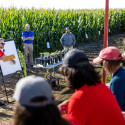Advances
Dairy farmers face health insurance crisis
Although farming is one of the most dangerous occupations in Wisconsin, a new study from UW–Madison shows that more than 40 percent of dairy farmers either have no health insurance or have plans that don’t cover all their family members.
Last spring, researchers from the university’s Program on Agricultural Technology surveyed some 1,600 dairy farmers; the results are based on 869 responses.
The findings show that 18 percent of dairy farm families have no insurance and only 59 percent have health plans that cover all family members. About 80 percent of the families lack health insurance that includes routine visits to doctors and other preventative care.
“This situation is bad both for Wisconsin dairy farm families and for the dairy sector as a whole,” says Jeremy Foltz, an economist and associate director of PATS. “It should be a great concern in Wisconsin where dairy farming generates billions of dollars of farm and manufactured product sales.”
PATS will continue to study the issue and plans to bring diverse groups together to explore alternatives.
Without fire, red pines could disappear
According to a new computer model, the towering groves of red pine trees characteristic of Minnesota’s Boundary Water Canoe Area could completely disappear unless fire is reintroduced.
Before people settled the area in the early 1900s, fires — started primarily by lightning bolts — swept through the area every 50 to 100 years. The blazes enabled the surviving trees, such as the red pine, to reproduce more easily. But when settlers started taking active measures to suppress natural fires, red pines experienced more difficulty regenerating.
Robert Scheller, a graduate student working with David Mladenoff, a professor of forest ecology and management, developed a model that shows the outcomes of both fire suppression and fires about every 50, 100 or 300 years. He used the landscape simulation model LANDIS — developed at UW–Madison — to predict what might happen if fire were reintroduced.
The model shows that continued fire suppression would lead to the disappearance of not just red pines but also jack pine, aspen and birch trees within 300 years. “If full fire suppression continues,” Scheller explains, “the forest may never recover and red pine may be lost as a locally dominant species.”
The model suggests that fires every 50 to 100 years would maintain tree diversity; a fire every 50 years would increase the number of red pines.
New study to measure farm phosphorous and soil loss
While nutrient-rich soil helps farms produce healthier crops, some of those nutrients run off the land and pollute surface and groundwater. A team of UW–Madison researchers, led by soil physicist John Norman, will quantify the losses of dissolved and sediment-bound phosphorus from two watersheds on a family farm in west central Wisconsin. The land contains the headwaters of two tributaries to Traverse Valley Creek, a Class 1 trout stream.
The researchers will incorporate new approaches to measuring phosphorus movement and express their results in the framework of a computer model. Norman says the model would then help various groups, including state agencies, study and evaluate how farm management decisions could affect farm productivity and profitability, as well as environmental quality.
Tags: research




